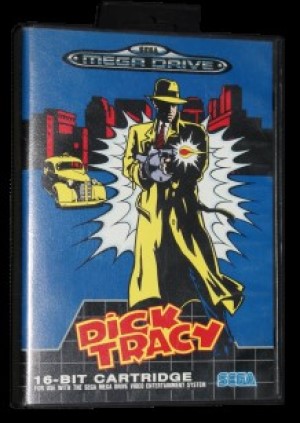
As a life-long fan of the character, Warren Beatty had trailed a Dick Tracy concept around the studios since the 1970s (and he's still at it). For those not in the know, it was a comic strip that began in the Detroit Mirror in the 1930s. Coming off the back of the "golden age" of American gangsterism, pitting a tough-but-honest detective against larger-than-life villains, Dick Tracy has been in continuous print for over 80 years. His box office outing in 1990 came shortly after Tim Burton's Batman sent cinema goers bananas. At the time, you couldn't move for Batmania - but more of that another time. Beatty and Disney hoped Dick Tracy would have a similar impact, and they tried to make a splash with the sorts of promotional tie-ins Batman had. It didn't do anywhere near as well, though the film itself was okay. Nor was it a fantastic hit for the Genesis/MegaDrive, despite Sega giving their interpretation a release in Japan and Europe, and a Master System port. And that's a shame, because it's good.
Yes, there was once a time when tie-in games were often a treat to play. Dick Tracy for the MegaDrive is a (mostly) slow-paced sideways scroller that has you punching and shooting your way through hordes of Big Boy's thugs 'n' hoods. There are some very minor platforming elements, and its design and feel owes a little bit to the original Shinobi and Rolling Thunder, except our Dick is as nimble as neither. One neat and original addition is a splitting of the play area into foreground and background. The former is your standard shooting/punching action, but at various intervals henchmen appear in the background and start opening up. Handily, under that trade mark trench coat Tracy is packing a tommy gun of his own, and you can let rip back. Using the joypad to do this takes some practice, but when you can mow down rows of bodies it does bring a certain satisfaction to proceedings.
As you might have gathered, the end of the level sees you squaring up against a boss. Here, Big Boy's minions from the film take their turn to get killed. These take the form of background shooting as well, and tend not to be terribly onerous once you get the hang of things. That is, until you get to Flattop and then Big Boy himself. It's not that they're difficult - the time limit can be punishing.
And punishing is something the game is. While the bosses are relatively okay, except for the aforementioned, it can get very tricky very quickly. Had I this game 25 years ago, I wouldn't like to think how many hours I would have sunk into it to learn the tricky attack patterns. On the final level, for instance, Tracy is simultaneously assailed by hoods that lie down and jump your bullets, roll in and off screen to avoid them, while coming under fire from the tommy guns in the background. There are the levels where Tracy has to rely on fisticuffs against armed gangsters, and that requires repeated trial and error. And perhaps the most disconcerting are the car chase sequences. Tracy clings to the side of the patrol car while enemies shoot from cars in the foreground and background. I swear there are several motors with a dozen baddies in each. These too require more ducking and a diving than an average Fools and Horses episode. It's a good job that the acquisition of multiple continues via the bonus round is quite easy to do. Nevertheless, I'd go so far to say this is the hardest MegaDrive game I've played that isn't broken. Yet Dick Tracy manages to pull off a gaming experience that, on the surface, should be frustrating but refuses to be.
There is something very arcadey about Dick Tracy meaning it wouldn't look out of place in, well, an arcade. The graphics are well-drawn and follows the aesthetic of the film faithfully. The music is so-so, which is to be expected as North American developers didn't know what to do with the sound hardware, but on the whole it's a fun and well-crafted experience. Plus it has the bonus of not featuring the annoying Kid of the movie.
Coming back to the two play fields that were "accessed" simultaneously, this might have been the first appearance of such in a 2D side-scroller. As it worked well here (and it was received positively by contemporary critics), it is unusual that it didn't make a repeat appearance in later titles. As with Atomic Robo-Kid, also for the Genesis/MegaDrive, Dick Tracy attempts to inject something new into what was already a tired and highly-standardised game format. In this case the gameplay innovation was a fun addition, but that did not prevent it from being something of an evolutionary dead end.
No comments:
Post a Comment
Comments are under moderation.